November 2025

The global pyrogen testing market size is projected to grow from USD 1.55 billion in 2025 to USD 3.35 billion by 2034, at a compound annual growth rate (CAGR) of 8.91% from 2025 to 2034.
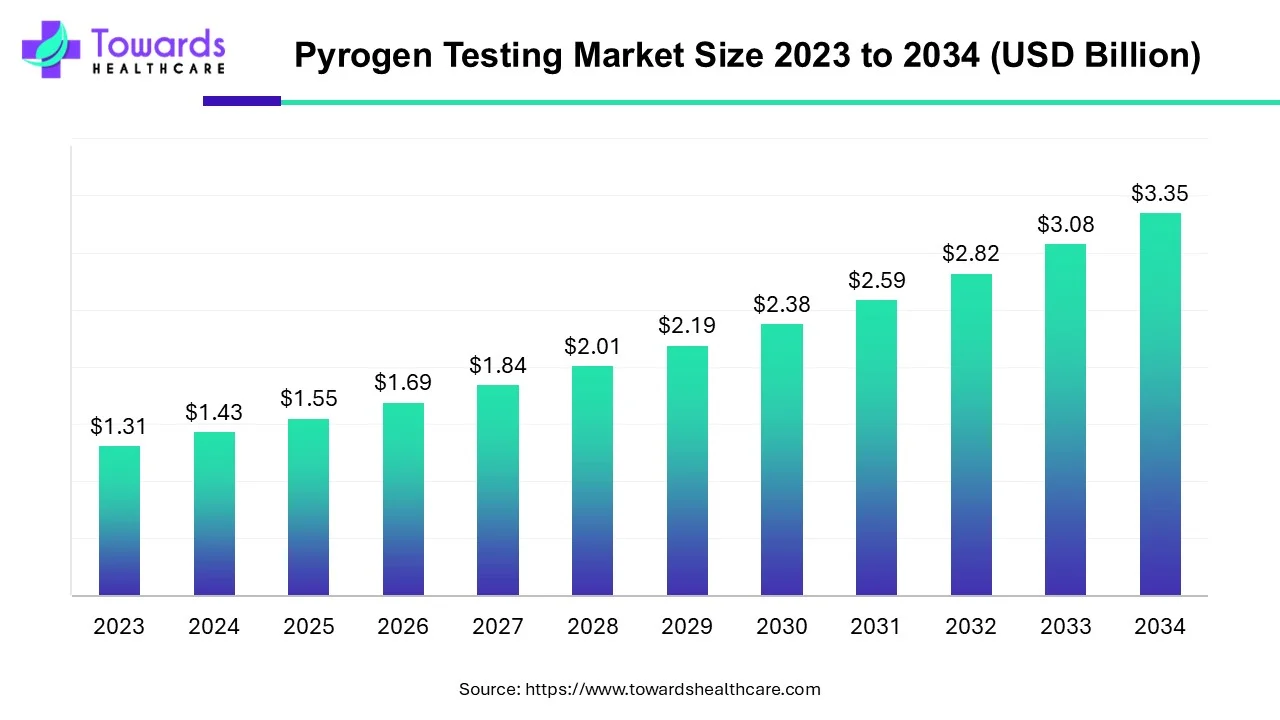
| Metric | Details |
| Market Size in 2024 | USD 1.43 Billion |
| Projected Market Size in 2034 | USD 3.35 Billion |
| CAGR (2025 - 2034) | 8.91% |
| Leading Region | North America |
| Market Segmentation | By Product, By Test Type, By End-use and By Region |
| Top Key Players | Charles River Laboratories (CRL), Lonza Group, Associates of Cape Cod, Inc., FUJIFILM Wako Chemicals U.S.A. Corporation (Pyrostar), Ellab A/S, Merck KGaA, bioMérieux SA, GenScript Biotech, Thermo Fisher Scientific, Inc. |
Pyrogen testing is a term frequently used by pharmaceutical corporations and drug producers to determine whether vaccinations and drugs include bacterial toxins that have the potential to cause fever when given to humans. The primary drivers driving the growth of the pyrogen testing market are increased activity in the biotechnology and pharmaceutical industries, tighter laws controlling pharmaceuticals and medical devices, and rising public awareness of the potential risks associated with pyrogens in medical products.
AI techniques are mostly employed in industrial microbiology for the purposes of quality assurance, bacterial identification, and upholding hygienic standards. AI improves medication efficacy and safety, which is critical for public health. AI-driven solutions are revolutionizing the cosmetics industry by putting safety and purity first in product creation. AI improves food safety and healthcare product standards in veterinary medicine, ensuring food production quality assurance.
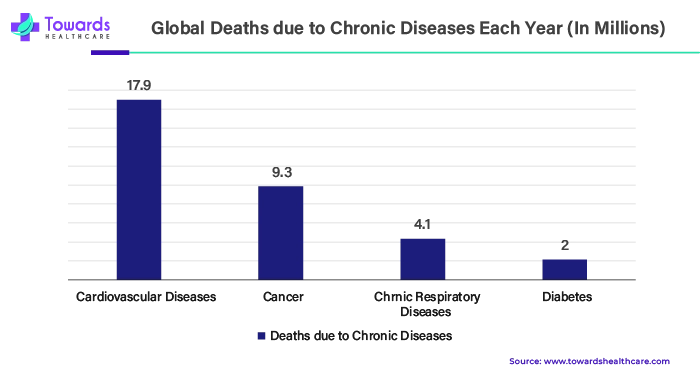
Noncommunicable diseases (NCDs) account for 41 million annual deaths worldwide, or 74% of all fatalities, according to the WHO. Research indicates that 17 million deaths from NCDs happen before the age of 70. It is estimated that 86% of these premature deaths take place in low- and middle-income nations. The need for pyrogen-free goods is bolstered by the rising prevalence of chronic illnesses and the related rise in medical treatments and interventions, which in turn drives market expansion.
The high cost of testing reagents and equipment places restrictions on the market for pyrogen testing. Because necessary equipment and supplies are costly, smaller labs and organizations with tighter budgets may find it difficult to meet their needs. Financial difficulties are further increased by ongoing costs for consumables, calibration, and equipment maintenance. These high expenses prevent both new players in the industry and established companies from growing their pyrogen testing capacities.
The pyrogen testing industry is seeing an increase in the use of automation technologies to streamline processes and increase productivity. Processes like sample preparation, data processing, and instrument operation may be automated to significantly reduce testing time and human mistakes. High-throughput pyrogen testing is becoming more and more necessary, and test kit technical advancements are supplying assays that are simpler and faster to execute.
By product, the consumables segment held the largest share of the pyrogen testing market in 2023. An essential component of any chemical reaction is a reagent. In most commonly used assays, reagents are substances or compounds that have the ability to promote a reaction. Reagents such as the ES buffer for particular endotoxin testing, endotoxin-free reagent water, endotoxin indicators, endotoxin extraction solution, and curdlan can be used with any of the pyrogen testing kits that are currently on the market.
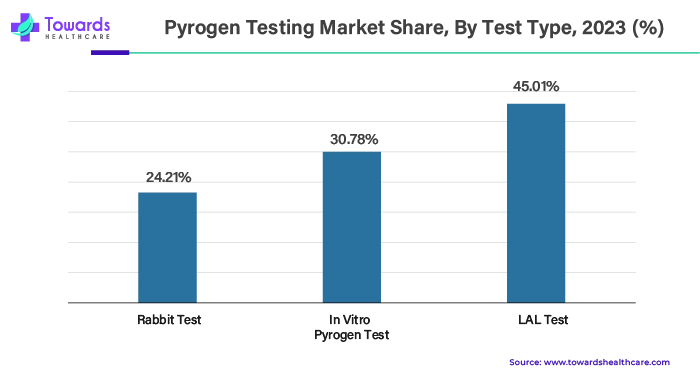
By test type, the LAL test segment dominated the pyrogen testing market by 45.01% in 2023. Later on, the Limulus Ameobocyte Lysate (LAL) test took the role of the rabbit pyrogen test and is now the most often used method. Horseshoe crab blood has an enzyme in it that, when exposed to endotoxins, helps the blood clot. As a result, endotoxin levels may be accurately detected and measured. For various purposes, there are several LAL test variants available. The LAL gel clot test is the most basic version. By eliminating individual variability and reducing possible sources of error, the test enables direct determination of endotoxin levels. Besides being commercially available, the test is also quick and affordable.
By end-use, the pharmaceutical and biotechnologies companies segment held the largest share of the pyrogen testing market in 2023. In order to guarantee the safety of medical devices and parenteral pharmaceutical products, testing for pyrogens is essential. As part of the required release testing, it helps prevent potentially fatal fever responses brought on by pyrogenic chemicals. The Food and Drug Administration (FDA), the United States Pharmacopeia (USP), and the European Pharmacopeia (EP) are just a few of the bodies that govern pyrogen testing, which ascertains whether or not pyrogens are present in parenteral pharmaceutical goods.
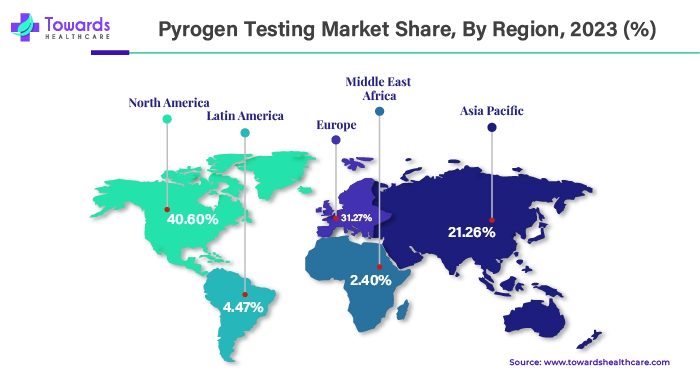
By region, North America dominated the pyrogen testing market share by 40.60% in 2024. In North America, the biotechnology and pharmaceutical industries have been steadily expanding. Research and development efforts in the area are concentrated, which results in the creation of novel medications, biologics, and medical equipment. As the business increases, so does the necessity for thorough testing, including this testing. As a result, these elements will increase the segment's demand. Furthermore, it is anticipated that the need for these tests will increase in order to produce safer and more effective medications due to the growing developments in the biotechnology and pharmaceutical sectors as well as the rising number of new biologics research and debuts.
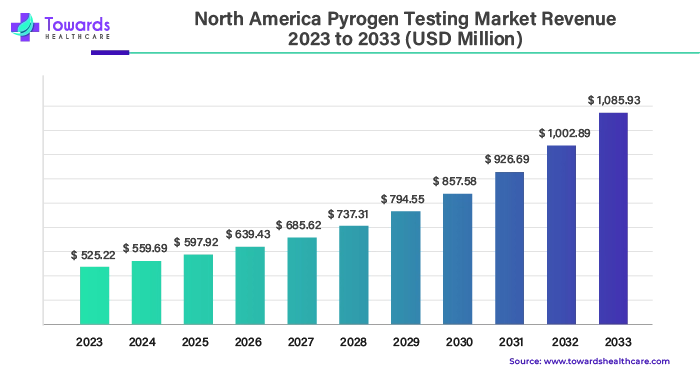
In North America, the Pyrogen Testing Market is anticipated to achieve a valuation of $525.22 million by 2023, driven by a growing CAGR of 6.50%. This growth reflects the increasing demand for pyrogen testing across various industries, including pharmaceuticals, biotechnology, and medical devices, as companies and regulatory bodies emphasize the importance of ensuring the safety and sterility of products.
The pyrogen testing market is dominated by the U.S. in North America. The primary reasons for this include the nation's sophisticated healthcare system, increased emphasis on the development of novel drugs, and the presence of important biotechnology and biopharmaceutical firms like Pfizer Inc. and F. Hoffmann-La Roche AG.
Moreover, Canada is bringing in a significant amount of money for the North American sector. This is explained by the expanding R&D activities in the nation, the burgeoning pharmaceutical and biotechnology sectors, and the growing public knowledge of the safety of pharmaceuticals. Among Canada's most inventive industries is the pharmaceutical business. It is made up of businesses that create and produce over-the-counter medication goods, generic medications, and novel medicines.
With a 2.2% market share in pharmaceutical sales worldwide, Canada ranks eighth in the globe. In Canada, sales of brand-name products make up 80.5% of total sales by value and 25.7% of prescriptions by quantity. By value, 19.5% of market sales and 74.3% of market share by prescriptions are made up of generics. Pharmacies exports and imports from Canada to the rest of the world grew by 38% and 55%, respectively, between 2018 and 2022.
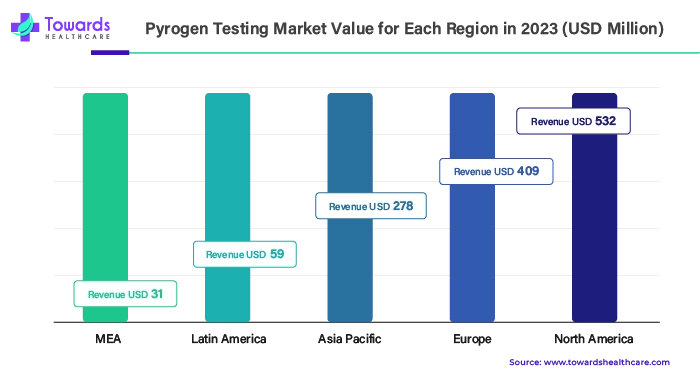
Asia Pacific is expected to grow at the fastest rate during the forecast period. Stringent laws and policies governing the development of drugs. Growth in the biotechnology and pharmaceutical industries, as well as increased spending on healthcare facilities in this area. Businesses are using specialist testing facilities to handle these testing services on an increasing basis. Manufacturers may acquire cutting-edge testing facilities and knowledge through outsourcing without having to make substantial upfront expenditures on staff and equipment. Smaller businesses trying to focus on their core skills and optimize their testing procedures are more likely to see this trend. Furthermore, innovation continues to lead the industry in the creation of novel testing techniques, tools, and methods.
Drug manufacturing operations have seen a significant increase in the pharmaceutical industry in India. The requirement for quality assurance procedures, such as this testing, to make sure that the produced medications fulfill global safety and quality standards rises in direct proportion to the growth in pharmaceutical manufacturing. Reputable for producing low-cost vaccines and generic medications, the Indian pharmaceutical sector is the third largest producer of pharmaceuticals in the world by volume. For 2021–2022, the pharmaceutical industry had an overall yearly turnover of Rs. 3,44,125 crores (USD 42.34 billion). A trade surplus of Rs. 1,14,895 crores (USD 15.44 billion) was generated in 2021–22 as a consequence of pharmaceutical exports totaling Rs. 1,74,955 crore (USD 23.5 billion) and imports of Rs. 60,060 crores (USD 8.06 billion).
Europe is expected to grow significantly in the pyrogen testing market during the forecast period. Europe consists of well-developed pharmaceutical as well as biotechnological industries. These industries are continuously focusing on the development of new pyrogen testing techniques. Furthermore, the development of biologics, vaccines, gene therapies, etc., also requires pyrogen testing to ensure the products being developed are free from endotoxins. Moreover, the support provided by the regulatory bodies for the development of animal-free testing methods with improved sensitivity and specificity is also contributing to this growth. The adoption of new technologies also helps in the optimization of the process in pyrogen testing. Thus, all these factors, along with the government support, are promoting the market growth.
The industries in Germany are developing new gene therapy, vaccines, biosimilars, etc., due to increasing incidences of various diseases. This, in turn, increases the demand for the use of pyrogen testing methods in their development process. Similarly, the rising interest in the development of personalized medications is also driving the need for pyrogen testing. Hence, these rising developments are increasing the collaborations with the industries. The government is also providing support to the industries, which in turn improves the production process. Furthermore, the interest in the development of animal-free pyrogen testing is also driving the research in the institutes.

| Company Name | Charles River Laboratories |
| Headquarters | Massachusetts, U.S., North America |
| Recent Development | In January 2024, to introduce the Endosafe® TrilliumTM rCR cartridge product, Charles River Laboratories International, Inc. took their innovation a step further and integrated it with their recombinant cascade reagent (rCR). By adding a new animal-free testing option to its already extensive bacterial endotoxin testing (BET) portfolio, this product shortens manufacturing lead times and improves testing effectiveness. |
| Company Name | FUJIFILM Wako Chemicals |
| Headquarters | Virginia, U.S., North America |
| Recent Development | In June 2024, Fumir, the PYROSTAR Neo+ recombinant protein reagent, was used to identify bacterial endotoxins, and the LumiMAT Pyrogen Detection Kit (LumiMAT) was utilized for in vitro2 pyrogen testing. The LumiMAT is a next-generation monocyte activation test (MAT)1. FUJIFILM Wako Pure Chemicals Corporation is conducting these experiments. July 2024 saw the global introduction of the new PYROSTARTM Neo+ and LumiMAT testing kits, which superseded the previous pyrogen and endotoxin tests. |
By Product
By Test Type
By End-use
By Region
November 2025
October 2025
November 2025
November 2025